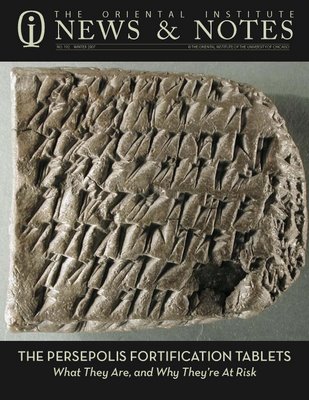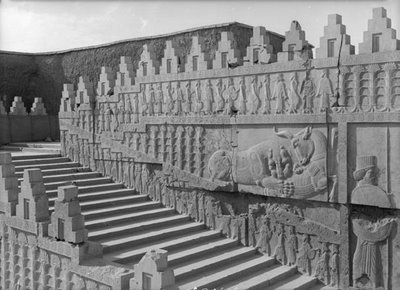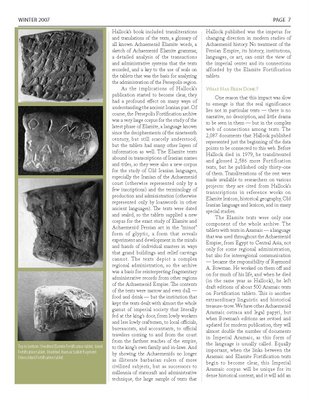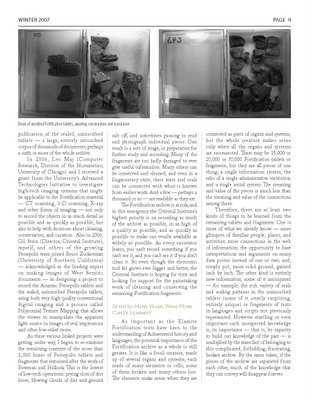
Matthew Stolper, John A. Wilson Professor of Oriental Studies, Oriental Institute
[See also A Heritage Threatened: The Persepolis Tablets Lawsuit and the Oriental Institute, by Gil J. Stein]
Darius I (522–486 B.C.) began to build the imperial residence complex at Persepolis (modern Takht-i Jamshid, near Shiraz in southwestern Iran) and the work flourished under his son Xerxes (486–465 B.C.) and under succeeding Achaemenid kings. The additions, alterations, and rebuilding came to a brutal end when Alexander the Great conquered, looted, and burned the palace complex in 330/329 B.C. Even in ruins, the massive platform, lofty columns, sculptured walls, and staircases were imposing, and for many centuries they attracted the attention of visitors. Some early European travelers brought back souvenirs, and others made records. Carsten Niehbuhr’s precise dawings of the trilingual cuneiform inscriptions on the visible ruins at Persepolis, made at the end of the eighteenth century, became the basis for the first steps in deciphering the cuneiform scripts at the beginning of the nineteenth.
But it was not until 1931 that an Oriental Institute expedition began to excavate what lay beneath these standing ruins. One entirely surprising discovery was a large group of clay tablets and fragments, proof that behind the splendid palaces and sculptured façades that were the setting for the court of the Great Kings stood an administrative apparatus that controlled movements of food, animals, and labor in the region around the palaces, the heartland of the Persians, and that apparatus relied on an information system that was as complex and sophisticated as any in the ancient world.
The tablets were unearthed in 1933 near a bastion of the fortification wall that surrounded the great platform and the hillside above it. The findspot gave its name to the Persepolis Fortification tablets. There were as many as 15,000 to 30,000 or more tablets and fragments. Most (thousands of tablets and tens of thousands of fragments) were in the Elamite language in cuneiform script. A few (hundreds of tablets and hundreds of fragments) were in the Aramaic language and script. Most inscribed tablets had impressions of seals, and thousands of other similarly shaped pieces had only seal impressions, with no text at all. There were single tablets in the Akkadian language in cuneiform script, in Greek language and script, and in an Anatolian script perhaps representing the Phrygian language. It took years to determine that the whole group came from the middle of the reign of Darius I, 509–494 B.C.

Above: Oblique aerial view of the Persepolis Terrace. OIM AE-560
What Do They Tell Us About?
The Fortification tablets came to Chicago in 1936, on loan for study. A team of scholars began work at once, but the vicissitudes of World War II and post-war professional circumstances shrank the team that had worked on the main body, the Elamite texts, to one man, Richard T. Hallock. Almost every part of Hallock’s task needed groundbreaking work, but the ground was new and hard. It was not until 1969 that Hallock published his exact, magisterial edition of 2,087 Elamite texts on Fortification tablets (Persepolis Fortification Tablets, OIP 92, usually abbreviated as PFT)

Hallock’s book included transliterations and translations of the texts, a glossary of all known Achaemenid Elamite words, a sketch of Achaemenid Elamite grammar, a detailed analysis of the transactions and administrative systems that the texts recorded, and a key to the use of seals on the tablets that was the basis for analyzing the administration of the Persepolis region.
As the implications of Hallock’s publication started to become clear, they had a profound effect on many ways of understanding the ancient Iranian past. Of course, the Persepolis Fortification archive was a very large corpus for the study of the latest phase of Elamite, a language known since the decipherments of the nineteenth century, but still scarcely understood, but the tablets had many other layers of information as well. The Elamite texts abound in transcriptions of Iranian names and titles, so they were also a new corpus for the study of Old Iranian languages, especially the Iranian of the Achaemenid court (otherwise represented only by a few inscriptions) and the terminology of production and administration (otherwise represented only by loanwords in other ancient languages). The texts were dated and sealed, so the tablets supplied a new corpus for the exact study of Elamite and Achaemenid Persian art in the “minor” form of glyptic, a form that reveals experiment and development in the minds and hands of individual masters in ways that grand buildings and relief carvings cannot. The texts depict a complex regional administration, so the archive was a basis for reinterpreting fragmentary administrative records from other regions of the Achaemenid Empire. The contents of the texts were narrow and even dull — food and drink — but the institution that kept the texts dealt with almost the whole gamut of imperial society that literallyfed at the king’s door, from lowly workers and less lowly craftsmen, to local officials, bureaucrats, and accountants, to official travelers coming to and from the court from the farthest reaches of the empire, to the king’s own family and in-laws. And by showing the Achaemenids no longer as illiterate barbarian rulers of more civilized subjects, but as successors to millennia of statecraft and administrative technique, the large sample of texts that Hallock published was the impetus for changing direction in modern studies of Achaemenid history. No treatment of the Persian Empire, its history, institutions, languages, or art, can omit the view of the imperial center and its connections afforded by the Elamite Fortification tablets.
What Has Been Done?
One reason that this impact was slow to emerge is that the real significance lies not in particular texts — there is no narrative, no description, and little drama to be seen in them — but in the complex web of connections among texts. The 2,087 documents that Hallock published represented just the beginning of the data points to be connected to this web. Before Hallock died in 1979, he transliterated and glossed 2,586 more Fortification texts, but he published only thirty-one of them. Transliterations of the rest were made available to researchers on various projects: they are cited from Hallock’s transcriptions in reference works on Elamite lexicon, historical geography, Old Iranian language and lexicon, and in many special studies.
The Elamite texts were only one component of the whole archive. The tablets with texts in Aramaic — a language that was used throughout the Achaemenid Empire, from Egypt to Central Asia, not only for some regional administration, but also for interregional communication, became the responsibility of Raymond Bowman. He worked on them off and on for much of his life, and when he died (in the same year as Hallock), he left draft editions of about 500 Aramaic texts on Fortification tablets. This is another extraordinary linguistic and historical treasure-trove. We have other Achaemenid Aramaic ostraca and legal papyri, but when Bowman’s editions are revised and updated for modern publication, they will almost double the number of documents in Imperial Aramaic, as this form of the language is usually called. Equally important, when the links between the Aramaic and Elamite Fortification texts begin to become clear, this Imperial Aramaic corpus will be unique for its dense historical context, and it will add an entirely new dimension to the information web of the Elamite texts.
Detail of the sculptured walls and grand staircase of the Persepolis palace complex. The Fortification tablets recorded the administrative structure of the Persian Empire
Both the Elamite and the Aramaic tablets carry the impressions of seals, usually of one or two seals, sometimes more. These are the visible representation of the people and offices that operated the institution that kept the tablets. For the users of these documents, they brought both identity and authority to the written information.Hallock identified impressions of more than a thousand distinct seals on the tablets in PFT, and since 1979, Margaret Root (University of Michigan)and Mark Garrison (Trinity University)have worked on a three-part publication of these and all the other seal impressions. The Oriental Institute published the first part in 2001 (OIP 117). It reveals still another dimension of the information in the Fortification archive, not only an array of art and craft, but also a compendium of connections among individuals, offices, operations, and images.

What Is Being Done?
The work left by Hallock and Bowman remains to be finished, and the Oriental Institute has begun to bring it to completion in forms that were unheard of when the work started, using electronic tools. Since 1989, Charles E. Jones (former Research Archivist, Oriental Institute, now at the American School of Classical Studies in Athens) and I have collaborated in collating Hallock’s transcriptions of unpublished Fortification texts (abbreviated as PF-NN) and transcribing them to computer files. Since 1996, we have collaborated with Gene Gragg (Professor and former Director, Oriental Institute), and since 2001 with Sandra Schloen (programmer, Oriental Institute) on a prototype electronic publication of PF-NN 0001–0300 in the On-line Cultural Heritage Resource Environment (OCHRE), adapting programs and standards developed for electronic publication of the Chicago Hittite Dictionary. Since 2003, I have supervised students and volunteers who are making and editing digital pictures of Elamite Fortification tablets to link to electronic editions of the texts.
Since 2006, Annalisa Azzoni (Vanderbilt University) has been revising and updating Bowman’s edition of Aramaic texts, and expanding it to include other such texts unknown to Bowman, also compiling the information in OCHRE in a form that will underlie an eventual publication. Elspeth Dusinberre (University of Colorado) has begun to work on the seal impressions on these Aramaic tablets, and in 2006, Garrison began a pilot project for analysis and publication of the sealed, uninscribed tablets — a large, entirely untouched corpus of thousands of documents, perhaps a sixth or more of the whole archive.

In 2006, Lec Maj (Computer Research, Division of the Humanities, University of Chicago) and I received a grant from the University’s Advanced Technologies Initiative to investigate high-tech imaging systems that might be applicable to the Fortification material
CT scanning, 3-D scanning, X-ray and other forms of imaging — not only to record the objects in as much detail as possible and as quickly as possible, but also to help with decisions about cleaning, conservation, and curation. Also in 2006, Gil Stein (Director, Oriental Institute), myself, and others of the growing Persepolis team joined Bruce Zuckerman (University of Southern California) acknowledged as the leading expert on making images of West Semitic documents — in designing a project to record the Aramaic Persepolis tablets and the sealed, uninscribed Persepolis tablets, using both very high quality conventional digital imaging and a process called Polynomial Texture Mapping that allows the viewer to manipulate the apparent light source in images of seal impressions and other low-relief items.
As these various linked projects were getting under way, I began to re-examine the remaining contents of the more than 2,300 boxes of Persepolis tablets and fragments that remained after the work of Bowman and Hallock. This is the lowest of low-tech operations: prying clots of dirt loose, blowing clouds of dirt and ground salt off, and sometimes pausing to read and photograph individual pieces. One result is a sort of triage, in preparation for further study and recording. Many of the fragments are too badly damaged to ever give useful information. Many others can be conserved and cleaned, and even in a fragmentary state, their texts and seals can be connected with what is known from earlier work. And a few — perhaps a thousand or so — are readable as they are.
The Fortification archive is at risk, and in this emergency the Oriental Institute’s highest priority is on recording as much of the archive as possible, in as high of a quality as possible, and as quickly as possible to make our results available as widely as possible. As every excavator learns, you can’t record something if you can’t see it, and you can’t see it if you don’t clean it. So even though the electronic tool kit grows ever bigger and better, the Oriental Institute is hoping for time and looking for support for the painstaking work of cleaning and conserving the remaining Fortification fragments.
As important as the Elamite Fortification texts have been to the understanding of Achaemenid history and languages, the potential importance of the Fortification archive as a whole is still greater. It is like a fossil creature, made up of several organs and systems, each made of many elements or cells, some of them broken and many others lost. The elements make sense when they are connected as parts of organs and systems, but the whole creature makes sense only when all the organs and systems are reconnected. There may be 15,000 or 20,000 or 30,000 Fortification tablets or fragments, but they are all pieces of one thing, a single information system, the relic of a single administrative institution and a single social system. The meaning and value of the pieces is much less than the meaning and value of the connections among them.
Therefore, there are at least two kinds of things to be learned from the remaining tablets and fragments. One is more of what we already know — more glimpses of familiar people, places, and activities; more connections in the web of information; the opportunity to base interpretations and arguments on many data points instead of one or two; and, simply put, more solid ground, gained inch by inch. The other kind is entirely new information, some of it anticipated — for example, the rich variety of seals and sealing patterns in the uninscribed tablets (some of it utterly surprising, entirely unique) or fragments of texts in languages and scripts not previously represented. However startling or even important such unexpected knowledge is, its importance — that is, its capacity to build our knowledge of the past — is multiplied by the mere fact of belonging to this complicated, forbidding, frustrating, broken archive. By the same token, if the pieces of the archive are separated from each other, much of the knowledge that they can convey will disappear forever.
[Following are the pages of these articles in the format in which they were originally published in The Oriental Institute News and Notes. The full issue is now online: 2007 Winter (#192)]








5 comments:
Post a Comment